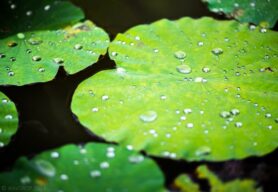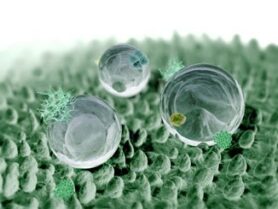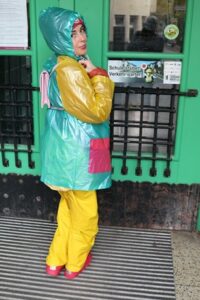Fashion of the Future
Raincoats – A Thing of the Past?
Imagine this: it’s the year 2035, and it has been raining for 5 weeks in a row (maybe climate change is real after all?). You think back to the times when rain still bothered you and laugh. Now, you just walk through the rain, and it does not make you wet. Even better: you are quite happy with the rain, as it even rinses your clothes – meaning you can delay doing your laundry for a while.
This may sound a bit far-fetched to you, but scientific developments that could lead to situations like this have been done already. With the help of nanotechnology, clothes can be made water- and dirt- repellent. Nanoclothes will therefore be stained much less compared to current clothes, meaning they have to be washed less. And who wouldn’t like to be able to delay doing laundry for a few extra days? Sweat will also be repelled by such clothes, so stinky clothes are much less of an issue. Also, gases can still travel through such clothes, meaning that they’re breathable. The technology could thus also be applied for sports clothing. How does this work, you might ask? Let’s dive right in!
The nanoclothes work in a way similar to leaves that you see around you. Take a lotus leaf for example. If a drop of water falls on the surface of such a leaf, it will form a droplet, like in the image below. This droplet can easily fall off the surface of the leaf. To understand more in detail how this works, we must zoom in on the surface of the leaf, to the nanoscale. At the nanoscale, we look at nanometres. A nanometre is very small: your own hair has a thickness of about 80.000 nanometres, so it’s not hard to imagine why you cannot see the nanoscale with your own eyes.

“_MG_2359_web – Rain drops on lotus leaves” by AlexDROP is licensed under CC BY-NC-ND 2.0
On the nanoscale, a lotus leaf has all kinds of structures on it, as you can see in the image below. The drops that you can see in this image are much smaller than in the previous image. The nanostructure of the leaves consists of small “pillars”. These structures are packed so closely together that drops of water cannot fit through. Gases like carbon dioxide are much smaller than drops of water, so they can still fit through. This is important because a plant needs gases to make energy.

Computer graphic of lotus leaf’s surface. Retrieved from https://asknature.org/strategy/surface-allows-self-cleaning/
Regular clothes, like the ones you are probably wearing now, consist of woven threads. There are a lot of tiny holes in between those threads. If you look closely at your clothes, you might be able to see them. When it’s raining, the drops of rain can go through these holes, making yourself and the clothes wet. In the same way, sweat and dirt stay in your clothes. Clothes thus get wet, stinky, or stained quickly, and we have to do a lot of washing and drying.
Nanotechnology is a solution to this problem. Clothes can be modified to have a nanolayer on top of them. This nanolayer consists of structures comparable to those of the lotus leaves. Nanolayers are placed on the top of the surface of clothes, which makes them extremely water- and dirt-repellent. Because the nanolayers are placed on top of clothes, the feeling of clothes does not change. This means you can still wear your favourite clothes, but just have some additional benefits ‘attached’ to them.
So, the technology exists. Why are clothes not being treated with it then? First of all, some nanomaterials have been proven to be harmful. Therefore, scientists have to be very careful and do thorough research on the safety of nanomaterials. A lot of developments in nanoscience have happened over the past years, and as Peter Clement said in the Sustainable Nano Podcast: “one of the downsides of all the advances in science that we’ve made [..] in the past 30 years, is we now have the power to alter the planet on a level that we’ve never had before, and we can do that for good or for bad.” Of course, there are no bad intentions in the production of nanoclothes, but as long as it cannot be proven that nanomaterials are safe, they will not be implemented in our clothes. “You have to think about impacts of what you’re making”.
Furthermore, more than 100 billion clothes are produced each year. If each of them would need a nanolayer, this would require a lot of nanomaterial. Such materials can be produced at a much larger scale than they could a while ago. “Industrial applications are quickly developed and commercialized, often increasing productivity and lowering cost”, says Peter Clement. Still, the amount of nanomaterial that can be produced is nowhere near the amount of clothes produced each year. Also, as can be told from Peter Clements’ quote, the cost of nanomaterial is still an issue. The addition of nanolayers to clothes will make them more expensive, and if they are too expensive people will not be buying them of course.
Scientists will have to do more research on the safety of nanolayers. Time has to be spent on improving the production of them as well. If those two challenges are solved, we can actually have water-repelling clothes a few years from now! Then the look in the image below will be one of the past.

“Halal german rubbergirl in rainwear” by Pierrehassan Vogel is marked with CC PDM 1.0
References
Yetisen, A. K. et al. Nanotechnology in Textiles ACS Nano 2016, 10, 3, 3042–3068 https://doi-org.proxy.library.uu.nl/10.1021/acsnano.5b08176
Marmur, A. The lotus effect: superhydrophobicity and metastability Langmuir 2004, 20, 3517– 3519 DOI: 10.1021/la036369u
Cherenack, K.; van Pieterson, L. Smart textiles: challenges and opportunities J. Appl. Phys. 2012, 112, 091301 DOI: 10.1063/1.4742728
Haseeb A. Khan, Rishi Shanker.Toxicity of Nanomaterials BioMed Research International 2015 DOI: 10.1155/2015/521014
Quotes are from Peter Clement, Sustainable Nano Podcast, Episode 9 ‘Seven Stages of Technological Adaptation’.
Image of the nano structure of a lotus leaf is retrieved from https://asknature.org/strategy/surface-allows-self-cleaning/

